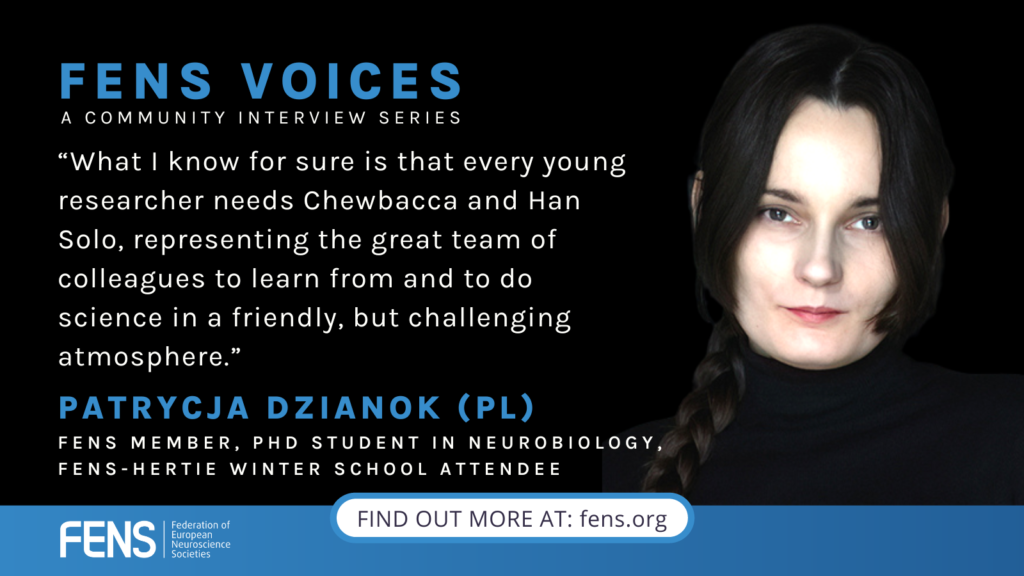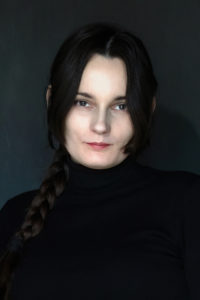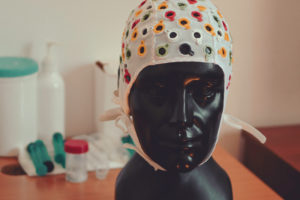
FENS Voices | Patrycja Dzianok: Finding “The Force” in neuroscience
06 January 2023
FENS News, Neuroscience News
FENS Voices begins 2023 by reconnecting with FENS member Patrycja Dzianok, a Polish neuroscientist who obtained a MSc in Cognitive Science and a BEng degree in Computer Science. She attended the FENS-Hertie Winter School in 2019 and is currently pursuing her PhD in Neurobiology at the Nencki Institute of Experimental Biology PAS, in Poland. Her research focuses on the study of early biomarkers for Alzheimer’s disease, and she was the recipient of the Polish National Science grant in 2018/2019 for the “Executive attention, genetic risk of Alzheimer’s disease and cingulate cortex: an EEG and fMRI study”. FENS has been proud to have supported her career goals and to feature her experiences and science here.

Some people find science dull, maybe because the information becomes very complex at a certain moment. What part of brain research spiked your curiosity? Was your initial interest in science tied to your family’s background?
PD: It seems that a large number of scientists are following the footsteps of their family parents. Coming from a family with an academic background and having grown up in such an environment certainly makes it easier to ignite a love for science. However, it is not the case with me. I chose this path myself, led by the conviction that I would like to do something really useful with my life, that would challenge me.
Neuroscience is all about the brain. And the brain is the organ that allows us to gain knowledge and to pursue discoveries in other disciplines. Therefore, it becomes really important to understand how the brain works, operates and to learn how it allows us to interact with the environment. The implications of brain research can impact every field of science. To name just a few inspiring concepts that neuroscience touches: cognitive biases and cognitive conflicts, the problem of consciousness, formation of memories and memory itself and many more. But ageing affects the brain, as much as any other organ. Alzheimer’s disease and related dementias do not seem to be an inevitable part of ageing. That being said, for the sake of our brains, it is good to study how we can detect neurodegenerative changes early on and know how we can prevent them. This is the topic that interests me the most at the moment.
What did you like most about studying Computer Science and how did you connect your Bachelor studies to Cognitive Science?
PD: Cognitive science is an interdisciplinary field that connects neuroscience, biology, psychology, philosophy, anthropology and computer science. There are classes on artificial intelligence, programming or mathematics during the course of Cognitive Science studies, but of course they are not so extensive, so it was quite natural to pursue a second diploma in Computer Science. What I liked most about Computer Science was learning how to “think” like a computer and, through that, learning programming. At the beginning, it’s quite hard to switch from the natural language that we all use to communicate, to the language that a computer could “understand”.
What/who would be the Darth Vader of an early career researcher and what/who would be Yoda?
PD: What I know for sure is that every young researcher needs Chewbacca and Han Solo, representing the great team of colleagues to learn from and to do science in a friendly, but challenging atmosphere. The supervisor/promotor can be either Yoda or Darth Vader, depending on chance – which is related to one’s personal experience. I had the luck to have a Yoda supervisor, as I believe every supervisor should be. Recently, there were a few articles, also in Nature, about the mental health of young researchers and PhD students, that were overlooked for years. So, Darth Vader would be the stressful, publish or perish culture and the low wages that could lead young scientists to develop anxiety and depression, which would force them to leave academia.
You received a Polish National Science grant in 2018 for your research in Alzheimer’s disease. How was it and what made you focus on AD?
PD: I’m probably repeating myself here, but I had this strong and cliché feeling that it would be nice to do something useful with my life. The results of research related to neurodegenerative diseases can have a real impact on improving the quality of life for many people in the future. Most of us also, at some time in our lives, were able to see how neurodegeneration changes a person – observing it either in close family members or the extended family. Early detection of this disease, thus implying a more effective and a faster treatment, could help people in the future to age with dignity.
 What can you tell us about your research related to the changes within granulocyte levels (blood tests) between risk-genes carriers vs non-carriers?
What can you tell us about your research related to the changes within granulocyte levels (blood tests) between risk-genes carriers vs non-carriers?
PD: In this grant, we are studying presymptomatic, healthy individuals with increased genetic risk of late-onset AD (APOE/PICALM) and trying to answer the question of how the risk genes may be related to brain activity and health in general and whether the direction of those presumed changes is similar to that detected in Alzheimer’s disease patients. We have found differences in blood granulocytes profiles (especially in eosinophils) between risk-carriers and non-carriers, that uncover early changes in the immune system related to chosen risk-genes. Inflammation is considered as a key mechanism leading to AD development and progression. Our paper on this topic is currently under the review process.
You are investigating changes in EEG features between risk-genes carriers vs non-carriers. Could you share with us some of your findings?
PD: Finding a battery of diagnostic biomarkers that could help to diagnose the disease in the pre-symptomatic period is crucial. An ideal biomarker should be easily-accessible, reliable, non-invasive and inexpensive. EEG and blood biomarkers possess all of these characteristics. The most known EEG signal feature and most sensitive EEG marker found among Alzheimer’s disease patients is so-called “slowing of the EEG”. EEG signals can be decomposed into several frequency bands. For example delta, theta, alpha and beta, from the slowest one to the fastest one. In great generalisation, the slowest waves are related to sleep/relaxation and the higher waves are related to every-day activities. This “slowing” occurs as an increased activity of slow waves, and reduced frequency of fast waves in the observed signal. It corresponds to the signal complexity, which decreases, and is also considered an AD hallmark. We have found the exact signal features that characterise Alzheimer’s disease patients (vs controls) among risk-carrier groups in comparison to non-carrier individuals in our experiments. Our paper on the subject will be soon submitted for publication.
You just mentioned that you will submit a paper. How is it to be published in an international science publication? Are there any hurdles?
PD: The publication process is difficult and tedious, and can be biased if no double-blind review system is used. This can be in fact a detriment to those just starting out in their careers, without strong connections to leading researchers and teams in the field. The other problem is a bias of non-reporting of negative findings by leading publishers. If your old and rusted p value is below 0.05 you are safe to publish, if it’s not – there’s a problem. The file drawer problem – keeping the negative findings in the drawer and not showing them to the world – can stop scientific progress in many disciplines.
How can we know if we risk developing Alzheimer’s?
PD: There are two forms of Alzheimer’s disease: early (familiar) and late (sporadic). The early form is genetically determined by mutation in APP, PS1 or PS2 genes. If anyone in the family was diagnosed with AD at an early age (in their 30s, 40s, early 50s etc.), it is advised to seek genetic counselling. This early form is quite rare and counts for 1-5% of all AD cases. The late (sporadic) form counts for 95-99% of all AD cases, but unfortunately the aetiology of this form is not yet fully understood. Age is the single most significant factor, so the risks of developing the disease are higher as we age. The genes play an important role too – especially APOE, the most known genetic factor for late-onset AD. Nonetheless, genotyping APOE is not advised and approved in the standard preventive, medical routine. Depending on the study, possession of one APOE-ε4 allele (which is considered risky) increases the risk of developing AD by a threefold, and having two copies by 8-12 times. Having that in mind, one can have both copies of ε4 and never develop the disease. Other risk factors come into play, among them those related with health and one’s lifestyle (which are variable). High-risk factors include nicotinic addiction (smoking), obesity, diabetes, high blood pressure, high cholesterol, low intellectual and physical activity, head injuries, hearing loss, social isolation, sedentary lifestyle, poor diet and more. So how can we quantify the risk of developing AD? We can identify potential hazards by monitoring our daily life and activities. We can then try to reduce them by quitting smoking, changing our diet to a more balanced one, leading an active life etc. I hope that in the future we will be able to better and more accurately determine the risk of developing the disease (with use of machine/deep learning algorithms) to the level of publicly available medical prevention systems and introduce individual preventive therapies. I would like to contribute to the development of this future.
 Would it be possible to find a cure for AD in 10 or 20 years?
Would it be possible to find a cure for AD in 10 or 20 years?
PD: Developing the drug is quite a long and rigorous process, so I don’t think it will happen in the next 10 years. For now, the only drugs that are available are symptomatic ones that can slow the progression of the disease. In 2021, the U.S. Food and Drug Agency approved the first drug in around 20 years, with some controversy about its efficacy which still needs more research. But I have high hopes that in 20 years it could be possible. Especially given that research regarding biomarkers could accelerate the diagnosis, as one of the failures related to drug development is attributed to the fact that the drugs are administered to patients in advanced stages of the disease.
Do you look up to anyone in neuroscience? If so, what makes that person special?
PD: Scientific research is now visibly collective. Every year, there are so many papers coming out on a given topic that it becomes difficult to follow only one or two scientists. I believe there are many great neuroscientists that communicate and popularise neuroscience in a wonderful way. The first name that came to my mind was Robert Sapolsky, with his great personality, humour and storytelling skills; his work is generally focused on how stress impacts the brain and behaviour. Secondly, Frans de Waal, who taught us how marvellous, empathic and smart animals are. I read almost all of his books, and I was present at his talk during the FENS Forum from Berlin a few years ago.
The FENS-Hertie Winter School 2023 offers the opportunity to connect and network with world class researchers outside the context of a lab. You were a FENS-Hertie Winter School 2019 participant. What was your experience and how has it impacted your career?
PD: The FENS-Hertie Winter School was one of the best scientific schools/programmes from my PhD studies. I received my grant (related to genetics) before I attended the school, before I started to implement the experiments. It helped me a lot with precise planning of the experiments I wanted to carry out. I also received a lot of help when it came to the technical aspects related to implementing the research, especially learning about the genetic tests/methods available, the best practices, costs etc. I learned a lot about genetic and epigenetic mechanisms, as I didn’t have a background in that area of research back then.
Why is the FENS-Hertie Winter School an important experience for early career researchers?
PD: FENS schools give a great opportunity to network with peers and increase social skills, which can prove to be important in one’s development and career. Certainly, you are able to meet the best scientists related to a given school’s theme and dive into the topic profoundly, learning details regarding particular areas of interest. The participants come from all over the world, with an inspiring mixture of science ideas and experiences. The schools are organised in a way in which there is time for everything: lectures, working in groups on a given project, poster session and free time. This free time can be actively spent in nature or doing sports, which is great. I would certainly recommend attending a FENS school to every early career researcher.
About the FENS-Hertie Winter Schools
The FENS-Hertie Winter Schools are run within an intimate setting in Obergurgl, Austria, by leading scientists around novel concepts and theories in neuroscience. This format facilitates exchange between students and faculty and is a great opportunity for participants to develop new ideas, network and broaden their horizons. The FENS-Hertie Winter School 2023 will be on “Neuro-immune interactions in health and disease”. Find out more here.
About the Federation of European Neuroscience Societies (FENS)
Founded in 1998, the Federation of European Neuroscience Societies is the main organisation for neuroscience in Europe. It currently represents 44 national and single-discipline neuroscience societies across 33 European countries and more than 22,000 member scientists. Discover FENS and subscribe to our biweekly News Alert, with information on our latest calls and activities.